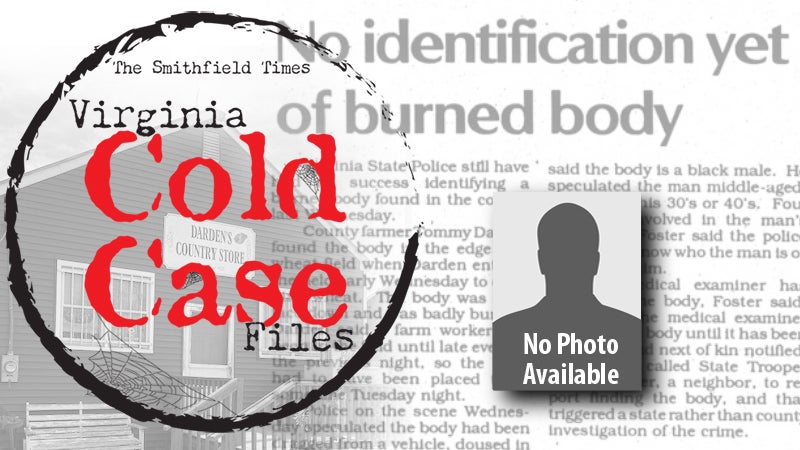Cold Case: Who left a burned body in the Darden family’s field in 1991?
Published 5:30 pm Friday, November 25, 2022

- The Smithfield Times reported in 1991 that a then-unidentified, badly burned body had been found lying face down in a wheat field owned by Tommy and Dee Dee Darden of Darden's Country Store. Virginia State Police have since identified the victim as 33-year-old Thomas Daryle Williams of New York City, but after 31 years still don't know who killed him.
Editor’s note: A new state law requires Virginia State Police to maintain a publicly accessible online database of unsolved homicides, unidentified bodies and missing-person cases. Three of the database’s 60 cases are from Isle of Wight County. This is the third in a multi-part series.
Dee Dee Darden remembers the grisly sight that greeted her the morning of Wednesday, June 5, 1991, like it was yesterday.
Her late husband, Tommy, had gone out early that morning to one of the couple’s wheat fields on Bowling Green Road, only to return a few minutes later in a panic.
“He came flying back down the road, saying, ‘Get in the truck; get in the truck! You gotta see it; you gotta see it!” Dee Dee recalled in a recent interview at her longtime business, Darden’s Country Store.
In the field, lying face down, was the badly burned body of a Black man police later identified as 33-year-old Thomas Daryle Williams of New York City.
The murder remains unsolved, as one of three decades-old Isle of Wight County crimes listed in an online Virginia State Police database of cold cases that made its debut in June.
The Smithfield Times could find only one article in its archives, dated June 12, 1991, and none in any other Virginia newspaper concerning the murder. The lack of media coverage from the day stands in stark contrast with the extensive reporting across multiple publications on the 1987 double homicide at Ragged Island the Times profiled in its Sept. 28 and Oct. 25 editions as part of its multi-part cold case series.
Tommy Darden speculated in the Times’ 1991 story that the murder had likely occurred sometime overnight, noting that one of his farmhands had been working in the field until late in the evening on Tuesday, June 4.
According to Dee Dee, Tommy found Williams’ body at the end of a long, gated, dirt path through the wheat field, which the Dardens usually kept locked but had left open the evening of June 4 to allow their farmhands to continue into the night collecting wheat.
“We always wondered how did anybody know where that path was,” Dee Dee said.
The person who killed Williams, she recalled, had wrapped his body in a curtain before setting him on fire. The metal curtain rings were still laying in the field that morning. Williams, she recalled, had been wearing tennis shoes with metal hooks for shoelaces, which were also still identifiable following the fire.
Had the Dardens not been planning to leave early that morning to attend their daughter’s kindergarten graduation and take some cattle to a market in Smithfield, they might not have seen anything. But Tommy wanted to check the field before heading out to see how much wheat his farmhands had collected, Dee Dee recalls.
After driving Dee Dee to the scene around 7 a.m., Tommy called his neighbor, State Trooper Elwin Kessler, resulting in the case becoming the purview of the Virginia State Police rather than the Isle of Wight County Sheriff’s Office. Kessler died in 2009.
According to the Times’ June 12, 1991, story, police speculated at the time that Williams’ body had been dragged from a vehicle and doused in some type of fuel before being set afire.
According to the State Police cold case database, Williams’ body also showed signs of having been beaten and mutilated.
The State Police declined to provide the Times with documentation from the case file, citing that the case, though cold, “remains an active investigation.”
Who was Thomas Daryle Williams?
One week after the Dardens’ grisly discovery, the state medical examiner still hadn’t identified the victim, let alone any evidence of who killed him, according to the Times’ 1991 story.
According to State Police Public Relations Director Corinne Geller, the case agent at the time had contacted 16 different law enforcement agencies, including some in Canada, to compare the victim with their missing-person reports, but none proved to be a match.
Later that month, police received a tip from an unnamed person that resulted in the medical examiner identifying the body as Williams based on dental records obtained from New York’s Department of Corrections — indicating Williams had served time in prison.
The Times submitted a request under New York’s Freedom of Information Law for records pertaining to Williams’ conviction and prison sentence on Nov. 4. Under New York’s FOIL, state agencies have up to 20 days to grant or deny a request for records.
The Times received two responses to its FOIL request, one on Nov. 16 stating there was more than one Thomas Williams in the state’s criminal justice records system who would have been 33 as of June 5, 1991, and another on Nov. 22 denying the request on grounds that criminal history records are “specifically exempted from disclosure” under New York’s Public Officers Law.
According to Geller, Williams was a native of New York’s borough of Queens, and still has family there. During the course of its investigation, the State Police have maintained contact with Williams’ sister.
At the time of his death, Williams had three young children. State Police have pursued “several leads” as to what led Williams to travel just over 430 miles south to Isle of Wight, Geller said. But 31 years later, it remains a mystery.
The Times asked on Nov. 4 that State Police pass along a reporter’s contact information and request for an interview to Williams’ sister, and confirmed on Nov. 9 that case agents had done so. But to date the Times has received no response from the sister or any other surviving family member.
The Times filed a Freedom of Information Act request with the Virginia Department of Health’s Office of Vital Records for a copy of Williams’ death certificate on Oct. 14. It was denied Oct. 17 on grounds that the Office of Vital Records is “exempted” from FOIA, despite the department acknowledging in its denial that Virginia death certificates become public record after 25 years.
The Times tried again to obtain the document on Nov. 15, this time going through the Department of Health’s online portal for purchasing a certified copy, which was still pending as of Nov. 23. The death certificate, in addition to naming Williams’ next-of-kin, would typically list his last known occupation.
Dee Dee recalls being told by police that Williams had been recently released from prison, and that he had allegedly raped a drug dealer’s girlfriend — the theory at the time being that it was a revenge killing.
A modern-day lynching?
It’s been 90 years since Virginia saw a documented lynching, but the level of brutality in Williams’ murder, and his being a Black man accused of rape, raises the possibility of a racially motivated hate crime as well.
According to the website for the National Association for the Advancement of Colored People, or NAACP, lynchings were a type of extrajudicial killings perpetrated by mobs of white people against Black people during the 19th and 20th centuries — often for perceived sexual transgressions against white women.
A lynching, according to the NAACP, would typically involve a criminal accusation against a Black person, followed by an arrest and the assembly of a mob that would then abduct the accused, torture and murder the suspect. Lynchings “typically evoke images of Black men and women hanging from trees,” but “involved other extreme brutality, such as torture, mutilation, decapitation, and desecration,” with some victims “burned alive,” the NAACP’s website states.
According to a James Madison University database, there were 115 confirmed lynchings in Virginia from 1866 through 1932 and an additional six unconfirmed victims.
None are listed as having occurred in Isle of Wight, though a mob did form in the county in 1927.
According to past reporting by the Times and the now-defunct Richmond Planet, an African American newspaper published from 1883 to 1938, 25-year-old Shirley Winnegan, sometimes called Willingham, of Smithfield, was arrested and charged Oct. 14, 1927, with the rape and murder of a 14-year-old white girl.
A local lunacy commission had declared Winnegan legally insane in August of that year, making him ineligible for the death penalty.
The night of Winnegan’s arrest, a mob of 1,000 unmasked residents joined together and converged on Isle of Wight County’s jail, not realizing that then-Sheriff Willie Holmes Chapman had ordered Winnegan secretly moved to Petersburg’s jail. The mob reportedly cut Chapman’s telephone line while demanding to know where Winnegan was.
A few days before Chapman was to stand for reelection as sheriff, a second lunacy commission convened and declared Winnegan sane. Chapman ultimately lost his bid for reelection to William Colgate Whitehead, who’d been backed by the angry mob.
At his trial, Winnegan protested his innocence and “on the witness stand explained away every moment of his time from the hour he quit work … until he was arrested and spirited away to prevent a mob from taking his life,” the Planet reported.
Winnegan was ultimately convicted of the rape and murder, and was executed by electric chair on Jan. 25, 1926.
In a Nov. 21 interview at his home, Charlie Phelps, who served as sheriff of Isle of Wight from 1988 to 2011, only vaguely recalled reports of a body being found near the Dardens’ store during his tenure. Nor did Phelps recall ever working any racially motivated crimes.
“I had some Black-on-Black crimes and white-on-white crimes,” Phelps said.
As for whether it could have been drug-related, “I can’t say that we were really ever inundated with drug-related crime,” Phelps said, but “we had our share of it.”
The Dardens did ultimately still make it to their daughter’s kindergarten graduation and the Smithfield market, but then returned to watch as police worked the crime scene on their farm.
“It seemed like they were here almost all day,” Darden recalled.
But it wouldn’t be the last time someone came running up to Dee Dee’s door to tell her that the body of a murder victim had been spotted near her home.





